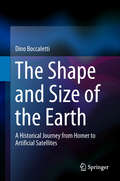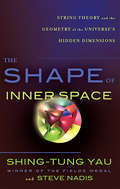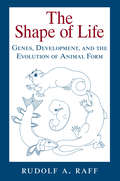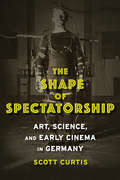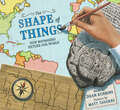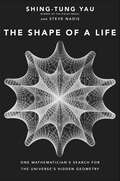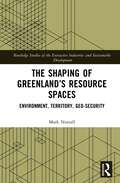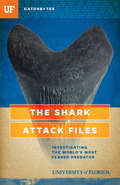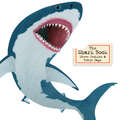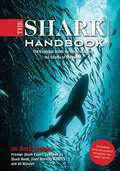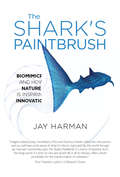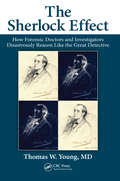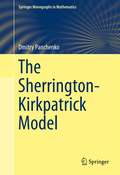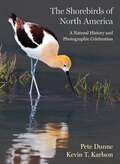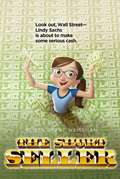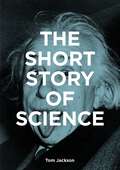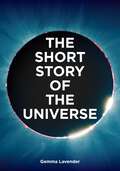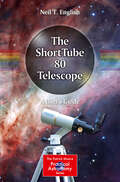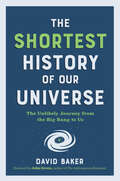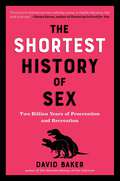- Table View
- List View
The Shape and Size of the Earth: A Historical Journey from Homer to Artificial Satellites
by Dino BoccalettiThis book describes in detail the various theories on the shape of the Earth from classical antiquity to the present day and examines how measurements of its form and dimensions have evolved throughout this period. The origins of the notion of the sphericity of the Earth are explained, dating back to Eratosthenes and beyond, and detailed attention is paid to the struggle to establish key discoveries as part of the cultural heritage of humanity. In this context, the roles played by the Catholic Church and the philosophers of the Middle Ages are scrutinized. Later contributions by such luminaries as Richer, Newton, Clairaut, Maupertuis, and Delambre are thoroughly reviewed, with exploration of the importance of mathematics in their geodetic enterprises. The culmination of progress in scientific research is the recognition that the reference figure is not a sphere but rather a geoid and that the earth’s shape is oblate. Today, satellite geodesy permits the solution of geodetic problems by means of precise measurements. Narrating this fascinating story from the very beginning not only casts light on our emerging understanding of the figure of the Earth but also offers profound insights into the broader evolution of human thought.
The Shape of Inner Space: String Theory and the Geometry of the Universe's Hidden Dimensions
by Shing-Tung Yau Steve NadisString theory says we live in a ten-dimensional universe, but that only four are accessible to our everyday senses. According to theorists, the missing six are curled up in bizarre structures known as Calabi-Yau manifolds. In The Shape of Inner Space, Shing-Tung Yau, the man who mathematically proved that these manifolds exist, argues that not only is geometry fundamental to string theory, it is also fundamental to the very nature of our universe.Time and again, where Yau has gone, physics has followed. Now for the first time, readers will follow Yau's penetrating thinking on where we've been, and where mathematics will take us next. A fascinating exploration of a world we are only just beginning to grasp, The Shape of Inner Space will change the way we consider the universe on both its grandest and smallest scales.
The Shape of Life: Genes, Development, and the Evolution of Animal Form
by Rudolf A. RaffRudolf Raff is recognized as a pioneer in evolutionary developmental biology. In their 1983 book, Embryos, Genes, and Evolution, Raff and co-author Thomas Kaufman proposed a synthesis of developmental and evolutionary biology. In The Shape of Life, Raff analyzes the rise of this new experimental discipline and lays out new research questions, hypotheses, and approaches to guide its development. Raff uses the evolution of animal body plans to exemplify the interplay between developmental mechanisms and evolutionary patterns. Animal body plans emerged half a billion years ago. Evolution within these body plans during this span of time has resulted in the tremendous diversity of living animal forms. Raff argues for an integrated approach to the study of the intertwined roles of development and evolution involving phylogenetic, comparative, and functional biology. This new synthesis will interest not only scientists working in these areas, but also paleontologists, zoologists, morphologists, molecular biologists, and geneticists.
The Shape of Spectatorship: Art, Science, and Early Cinema in Germany (Film and Culture Series)
by Scott CurtisScott Curtis draws our eye to the role of scientific, medical, educational, and aesthetic observation in shaping modern spectatorship. Focusing on the nontheatrical use of motion picture technology in Germany between the 1890s and World War I, he follows researchers, teachers, and intellectuals as they negotiated the fascinating, at times fraught relationship between technology, discipline, and expert vision. As these specialists struggled to come to terms with motion pictures, they advanced new ideas of mass spectatorship that continue to affect the way we make and experience film. Staging a brilliant collision between the moving image and scientific or medical observation, visual instruction, and aesthetic contemplation, The Shape of Spectatorship showcases early cinema's revolutionary impact on society and culture and the challenges the new medium placed on ways of seeing and learning.
The Shape of Things: How Mapmakers Picture Our World
by Dean RobbinsHow did the first people explore the land they lived on? How did civilizations expand their boundaries and chart courses into new lands? Learn about the history of cartography across cultures in this ode to mapmaking through the ages.Join history's first mapmakers as they explore the wonders of the world! In these pages, you&’ll find the tools ancient people used to depict their surroundings, methods different cartographers developed to survey new lands, and how we&’ve arrived at modern mapmaking today. Above all else, the thread that runs throughout thousands of years of civilization is the spirit of exploration that helps us measure the shape of things around us, the world we all share.
The Shape of a Life: One Mathematician's Search for the Universe's Hidden Geometry
by Shing-Tung Yau Steve NadisA Fields medalist recounts his lifelong effort to uncover the geometric shape—the Calabi-Yau manifold—that may store the hidden dimensions of our universe.Harvard geometer Shing-Tung Yau has provided a mathematical foundation for string theory, offered new insights into black holes, and mathematically demonstrated the stability of our universe. In this autobiography, Yau reflects on his improbable journey to becoming one of the world’s most distinguished mathematicians. Beginning with an impoverished childhood in China and Hong Kong, Yau takes readers through his doctoral studies at Berkeley during the height of the Vietnam War protests, his Fields Medal–winning proof of the Calabi conjecture, his return to China, and his pioneering work in geometric analysis. This new branch of geometry, which Yau built up with his friends and colleagues, has paved the way for solutions to several important and previously intransigent problems.With complicated ideas explained for a broad audience, this book offers not only insights into the life of an eminent mathematician, but also an accessible way to understand advanced and highly abstract concepts in mathematics and theoretical physics.“The remarkable story of one of the world’s most accomplished mathematicians . . . Yau’s personal journey—from escaping China as a youngster, leading a gang outside Hong Kong, becoming captivated by mathematics, to making breakthroughs that thrust him on the world stage—inspires us all with humankind’s irrepressible spirit of discovery.” —Brian Greene, New York Times–bestselling author of The Elegant Universe“An unexpectedly intimate look into a highly accomplished man, his colleagues and friends, the development of a new field of geometric analysis, and a glimpse into a truly uncommon mind.” —The Boston Globe“Engaging, eminently readable. . . . For those with a taste for elegant and largely jargon-free explanations of mathematics, The Shape of a Life promises hours of rewarding reading.” —American Scientist
The Shaping of Greenland’s Resource Spaces: Environment, Territory, Geo-Security (Routledge Studies of the Extractive Industries and Sustainable Development)
by Mark NuttallThe book examines ideas about the making and shaping of Greenland’s society, environment, and resource spaces. It discusses how Greenland’s resources have been extracted at different points in its history, shows how acquiring knowledge of subsurface environments has been crucial for matters of securitisation, and explores how the country is being imagined as an emerging frontier with vast mineral reserves. The book delves into the history and contemporary practice of geological exploration and considers the politics and corporate activities that frame discussion about extractive industries and resource zones. It touches upon resource policies, the nature of social and environmental assessments, and permitting processes, while the environmental and social effects of extractive industries are considered, alongside an assessment of the status of current and planned resource projects. In its exploration of the nature and place of territory and the subterranean in political and economic narratives, the book shows how the making of Greenland has and continues to be bound up with the shaping of resource spaces and with ambitions to extract resources from them. Yet the book shows that plans for extractive industries remain controversial. It concludes by considering the prospects for future development and debates on conservation and Indigenous rights, with reflections on how and where Greenland is positioned in the geopolitics of environmental governance and geo-security in the Arctic. This book will be of great interest to students and scholars of environmental anthropology, geography, resource management, extractive industries, environmental governance, international relations, geopolitics, Arctic studies, and sustainable development.
The Shaping of Life
by Lionel G. HarrisonBiological development, how organisms acquire their form, is one of the great frontiers in science. While a vast knowledge of the molecules involved in development has been gained in recent decades, big questions remain on the molecular organization and physics that shape cells, tissues and organisms. Physical scientists and biologists traditionally have very different backgrounds and perspectives, yet some of the fundamental questions in developmental biology will only be answered by combining expertise from a range of disciplines. This book is a personal account by Professor Lionel Harrison of an interdisciplinary approach to studying biological pattern formation. It articulates the power of studying dynamics in development: that to understand how an organism is made we must not only know the structure of its molecules; we must also understand how they interact and how fast they do so.
The Shark Attack Files: Investigating the World's Most Feared Predator
by Jeff Klinkenberg University of FloridaThe University of Florida has an ambitious goal: to harness the power of its faculty, staff, students, and alumni to solve some of society’s most pressing problems and to become a resource for the state of Florida, the nation, and the world. In 1958, a panel funded by the Office of Naval Research initiated the formation of the International Shark Attack File, the first comprehensive documentation of shark attacks on a global and historical level. In 1988, the file was transferred to the Florida Museum of Natural History at the University of Florida. It is part of the Florida Program for Shark Research, directed by George H. Burgess, the planet’s expert on shark attacks, and staffed by a world-renowned team of research scientists and educators. Travel the globe with Burgess, the Sherlock Holmes of shark attacks, as he studies mauled remains and the scars of the lucky survivors. His most famous case took him to an idyllic Red Sea resort where panic had set in after five attacks occurred in a single week. The attacks were carried out by Oceanic White Tips and a Mako, deep-water species that had no business being so close to the beach. Following the clues--dive-boat operators feeding sharks by hand to entertain tourists, the disappearance of the yearly tuna catch, and the dead sheep New Zealand cargo companies had been tossing overboard--Burgess solves the mystery of the shark attacks for Egyptian tourism officials and offers a list of best practices. But not all cases end with an easy prescription. In St. Petersburg Beach, Florida, he visits a recent shark-attack victim, bitten just off her dock on Boca Ciega Bay. While the victim would prefer to forget the fateful day the sharp-toothed jaws of the Bull Shark latched onto her leg just below the knee, Burgess gently coaxes the story from her. It will go in the file, to educate other shark researchers and educators and help us better understand the world’s most feared predator. The stories chronicled in Gatorbytes span all colleges and units across the UF campus. They detail the far reaching impact of UF’s research, technologies, and innovations--and the UF faculty members dedicated to them. Gatorbytes describe how UF is continuing to build on its strengths and extend the reach of its efforts so that it can help even more people in even more places.
The Shark Book
by Steve Jenkins Robin PageCaldecott Honor–winning team Steve Jenkins and Robin Page explore the astonishing lives of sharks in this brilliantly illustrated picture book. Perfect for Shark Week and all year round, this ode to the notorious ocean predator with more than four hundred species will blow you out of the water!Sharp teeth, super senses, and those infamous fins—what's not to love about sharks? Caldecott Honor–winning team Steve Jenkins and Robin Page explore one of the world's most notorious—and fearsome—animals. Learn what makes a shark a shark, what sharks like to eat, and how these predators of the deep have evolved. Ever wonder which shark is the smallest? Or the fastest? Even the most deadly? You'll find your answers in The Shark Book, with countless others. In this magnificently illustrated picture book, celebrate one of the worlds oldest species that has continued to capture our imaginations and astonish us for thousands of years.
The Shark Handbook: The Essential Guide for Understanding the Sharks of the World (Shark Week Author, Ocean Biology Books, Great White Shark, Aquatic History, Science and Nature Books, Gifts for Shark Fans)
by Greg SkomalDive deep into the world of sharks, the most fascinating and misunderstood marine animals on the planet, in this stunning new edition of The Shark Handbook, written by Shark Week expert, Dr. Greg Skomal.Did you know that a whale shark&’s spots are as unique as a fingerprint? Or that sharks can go into a trance when flipped upside down? Or that the Megallodon&’s mouth was 6 feet across? With The Shark Handbook, jump into brand new facts about these fierce sea creatures! Explore all of the orders of sharks, such as:Ground sharksGreat white sharksMackerel sharksCarpet sharksand more!Learn about over 400 profiles of every shark in existence, from the first sharks living about 445 million years ago to the ones lurking in the ocean deep today. Starring spectacular, full-color photography that makes these jaw-dropping sharks come to life, this is the perfect gift for the shark enthusiast in your life.Dr. Greg Skomal, PhD is an experienced aquarist and Marine Fisheries Biologist at Martha's Vineyard Fisheries, Division of Marine Fisheries, Massachusetts. He's been keeping saltwater aquariums since childhood and has shared his extensive knowledge with viewers of National Geographic, the Discovery Channel, NBC's Today, and other media.
The Shark's Paintbrush
by Jay HarmanWhy does the bumblebee have better aerodynamics than a 747? What structural design is shared by a tornado and a blood vessel?Since the Industrial Revolution, manufacturers have built things by a process known as "heat, beat, and treat." They use enormous amounts of energy to heat raw material, shape it with heavy machinery, and maintain its design, strength, and durability with toxic chemicals. Now, in a world of depleted natural resources, entrepreneurs and scientists are turning to nature to inspire future products that are more energy- and cost-efficient. Biomimicry, the science of employing nature to advance sustainable technology, is arguably one of the hottest new business concepts. At the center of this growing movement has been award-winning inventor and biomimetic entrepreneur Jay Harman.In The Shark's Paintbrush, Harman introduces us to pioneering engineers in a wide array of businesses who are uncovering and copying nature's hidden marvels. He shows business leaders and aspiring entrepreneurs how we can reconcile creating more powerful, lucrative technologies with maximizing sustainability. He injects a whole new vocabulary and way of thinking into the business sphere that speaks to both small start-ups and corporate giants.
The Shark's Paintbrush
by Jay HarmanWhy does the bumblebee have better aerodynamics than a 747? What structural design is shared by a tornado and a blood vessel?Since the Industrial Revolution, manufacturers have built things by a process known as "heat, beat, and treat." They use enormous amounts of energy to heat raw material, shape it with heavy machinery, and maintain its design, strength, and durability with toxic chemicals. Now, in a world of depleted natural resources, entrepreneurs and scientists are turning to nature to inspire future products that are more energy- and cost-efficient. Biomimicry, the science of employing nature to advance sustainable technology, is arguably one of the hottest new business concepts. At the center of this growing movement has been award-winning inventor and biomimetic entrepreneur Jay Harman.In The Shark's Paintbrush, Harman introduces us to pioneering engineers in a wide array of businesses who are uncovering and copying nature's hidden marvels. He shows business leaders and aspiring entrepreneurs how we can reconcile creating more powerful, lucrative technologies with maximizing sustainability. He injects a whole new vocabulary and way of thinking into the business sphere that speaks to both small start-ups and corporate giants.
The Sherlock Effect: How Forensic Doctors and Investigators Disastrously Reason Like the Great Detective
by Thomas W. YoungForensic science is in crisis and at a cross-roads. Movies and television dramas depict forensic heroes with high-tech tools and dazzling intellects who—inside an hour, notwithstanding commercials—piece together past-event puzzles from crime scenes and autopsies. Likewise, Sherlock Holmes—the iconic fictional detective, and the invention of forensic doctor Sir Arthur Conan Doyle—is held up as a paragon of forensic and scientific inspiration—does not "reason forward" as most people do, but "reasons backwards." Put more plainly, rather than learning the train of events and seeing whether the resultant clues match those events, Holmes determines what happened in the past by looking at the clues. Impressive and infallible as this technique appears to be—it must be recognized that infallibility lies only in works of fiction. Reasoning backward does not work in real life: reality is far less tidy. In courtrooms everywhere, innocent people pay the price of life imitating art, of science following detective fiction. In particular, this book looks at the long and disastrous shadow cast by that icon of deductive reasoning, Sherlock Holmes. In The Sherlock Effect, author Dr. Thomas W. Young shows why this Sherlock-Holmes-style reasoning does not work and, furthermore, how it can—and has led—to wrongful convictions. Dr. Alan Moritz, one of the early pioneers of forensic pathology in the United States, warned his colleagues in the 1950’s about making the Sherlock Holmes error. Little did Moritz realize how widespread the problem would eventually become, involving physicians in all other specialties of medicine and not just forensic pathologists. Dr. Young traces back how this situation evolved, looking back over the history of forensic medicine, revealing the chilling degree to which forensic experts fail us every day. While Dr. Young did not want to be the one to write this book, he has felt compelled in the interest of science and truth. This book is measured, well-reasoned, accessible, insightful, and—above all—compelling. As such, it is a must-read treatise for forensic doctors, forensic practitioners and students, judges, lawyers adjudicating cases in court, and anyone with an interest in forensic science.
The Sherrington-Kirkpatrick Model
by Dmitry PanchenkoThe celebrated Parisi solution of the Sherrington-Kirkpatrick model for spin glasses is one of the most important achievements in the field of disordered systems. Over the last three decades, through the efforts of theoretical physicists and mathematicians, the essential aspects of the Parisi solution were clarified and proved mathematically. The core ideas of the theory that emerged are the subject of this book, including the recent solution of the Parisi ultrametricity conjecture and a conceptually simple proof of the Parisi formula for the free energy. The treatment is self-contained and should be accessible to graduate students with a background in probability theory, with no prior knowledge of spin glasses. The methods involved in the analysis of the Sherrington-Kirkpatrick model also serve as a good illustration of such classical topics in probability as the Gaussian interpolation and concentration of measure, Poisson processes, and representation results for exchangeable arrays.
The Shorebirds of North America: A Natural History and Photographic Celebration
by Kevin T. Karlson Pete DunneA lavishly illustrated, large-format reference book by two preeminent experts on North American shorebirdsMore than half a century has passed since the publication of The Shorebirds of North America, Peter Matthiessen&’s masterful natural history of what is arguably the world&’s most amazing and specialized bird group. In the intervening decades, our knowledge about these birds has grown significantly, as have the threats to their populations and habitats. Pete Dunne and Kevin Karlson celebrate Matthiessen&’s classic book with this updated and expanded natural history of North American shorebirds. This elegantly written book begins by introducing readers to the unrivaled splendor of shorebirds and goes on to cover topics ranging from their biology and habitats to courtship and breeding, flight, the perils of migration, and conservation. Detailed accounts convey the richness and variety of the five family groups, with incisive, fact-filled descriptions of all 52 species of shorebirds known to breed in North America.Featuring hundreds of breathtaking images by Karlson and other photographers and drawing on the latest science, The Shorebirds of North America is a worthy tribute to Matthiessen&’s enduring work and an indispensable reference for bird lovers everywhere.
The Short Seller
by Elissa Brent WeissmanLook out Wall Street--Lindy Sachs is about to make some serious cash. A twelve-year-old takes on the stock market in this money-minded middle grade novel. It all starts when seventh grader Lindy Sachs is granted $100 and access to her father's online trading account as a way to alleviate her boredom while she's home sick from school. Lindy learns something immediately--she is very, very good at e-trading. Her $100 becomes $200. Then $400. And more. With trading talent and access to her parents' savings, the opportunity to make some real dough is too tempting to pass up. In fact, given how well Lindy's stocks are doing, it would be a disservice to not invest it all... Right?
The Short Seller
by Elissa Brent WeissmanA twelve-year-old takes on the stock market in this money-minded middle grade novel that Publishers Weekly calls "a smart pick."It all starts when seventh grader Lindy Sachs is granted one hundred dollars and access to her father's online trading account as a way to alleviate her boredom while she's home sick from school. Lindy learns something immediately--she is very, very good at e-trading. Her one hundred dollars soon becomes two hundred dollars. Then four hundred. And more. With trading talent and access to her parents' savings, the opportunity to make some real dough is too tempting to pass up. In fact, given how well Lindy's stocks are doing, it would be a disservice to not invest it all...Right?
The Short Story of Science: A Pocket Guide to Key Histories, Experiments, Theories, Instruments and Methods
by Tom Jackson Mark Fletcher'Nothing in life is to be feared. It is only to be understood. Now is the time to understand more, so that we may fear less' Marie CurieThe Short Story of Science is a new introduction to the complete subject of science. Covering 60 key experiments, from Archimedes' investigations of buoyancy to the discovery of dark matter, and then linking these to the history of science, as well as to the key theories and methods, the book simplifies and explains all the key breakthroughs.Accessible and concise, generously illustrated throughout, and with all the essential information presented without jargon, readers are given all the tools they need to enjoy the fascinating history of scientific knowledge.
The Short Story of Science: A Pocket Guide to Key Histories, Experiments, Theories, Instruments and Methods
by Tom Jackson Mark Fletcher'Nothing in life is to be feared. It is only to be understood. Now is the time to understand more, so that we may fear less' Marie CurieThe Short Story of Science is a new introduction to the complete subject of science. Covering 60 key experiments, from Archimedes' investigations of buoyancy to the discovery of dark matter, and then linking these to the history of science, as well as to the key theories and methods, the book simplifies and explains all the key breakthroughs.Accessible and concise, generously illustrated throughout, and with all the essential information presented without jargon, readers are given all the tools they need to enjoy the fascinating history of scientific knowledge.
The Short Story of the Universe: A Pocket Guide to the History, Structure, Theories and Building Blocks of the Cosmos
by Mark Fletcher Gemma LavenderThe Short Story of the Universe is a new introduction to the subject of the universe. Covering 130 key components that make it up - from dwarf galaxies and spiral arms to red giants and the planets of the solar sytem - and linking these to the universe's structure and the theories that help us understand it, this book simplifies this riveting yet mind-boggling subject, telling the story of how it came into being and how it will eventually be no more. Accessible and concise, generously illustrated throughout, and with all the essential information presented without jargon, readers are given all the tools they need to enjoy the fascinating history of the deepest depths of the universe.
The Short Story of the Universe: A Pocket Guide to the History, Structure, Theories and Building Blocks of the Cosmos
by Mark Fletcher Gemma LavenderThe Short Story of the Universe is a new introduction to the subject of the universe. Covering 130 key components that make it up - from dwarf galaxies and spiral arms to red giants and the planets of the solar sytem - and linking these to the universe's structure and the theories that help us understand it, this book simplifies this riveting yet mind-boggling subject, telling the story of how it came into being and how it will eventually be no more. Accessible and concise, generously illustrated throughout, and with all the essential information presented without jargon, readers are given all the tools they need to enjoy the fascinating history of the deepest depths of the universe.
The ShortTube 80 Telescope: A User's Guide (The Patrick Moore Practical Astronomy Series)
by Neil T. EnglishWelcome to the first comprehensive guide to one of the world’s most popular telescopes: the ShortTube 80 refractor. With its ultra-portability, versatility, and relatively low cost, this telescope continues to delight generations of stargazers.Starting in the field under a dark sky, the author walks the reader through a typical evening of stargazing, where the ShortTube 80 brings many astronomical treasures into focus. From there, he provides an in–depth account of the optical properties of the ShortTube 80 refractor and the accessories and mounting arrangements that maximize its potential both as a spotting ‘scope by day and an astronomical ‘scope by night.The main text discusses how the versatile ShortTube 80 can be used to study deep sky objects, the Sun, the Moon, bright planets and even high-resolution projects, where the instrument's features can be optimized for the observation of tight double and multiple stars. It explores how the ShortTube 80 can image targets using camera phones, DSLRs and dedicated astronomical CCD imagers.Packed with practical advice gained from years of firsthand stargazing experience, this book demonstrates exactly why ShortTube 80 has remained a firm favorite among amateur astronomers for over three decades, and why it is likely to remain popular for many years to come.
The Shortest History of Our Universe: The Unlikely Journey From The Big Bang To Us (Shortest History #0)
by David BakerA complete history of the universe, spanning 13.8 billion years in an ultra-accessible, uncommonly illuminating, exhilarating chronicle of key events “Baker introduces us not only to the history of our species and our planet, but the history of our vast universe.”—from the foreword by John Green, author of The Anthropocene Reviewed and The Fault in Our Stars In this thrilling history, David Baker captures the longest-possible time span—from the Big Bang to the present day—in an astonishingly concise retelling. His impressive timeline includes the “rise of complexity” in the cosmos and the creation of the first atoms; the origin of all galaxies, stars, and our solar system; and the evolution of life on Earth, from tiny single-celled organisms to human beings. Weaving together insights across the sciences—including chemistry, physics, biology, archaeology, and anthropology—Baker answers the fundamental questions: How did time begin? Why does matter exist? What made life on Earth the way it is? He also argues that never before has life on Earth been forced to adjust to a changing climate so rapidly, nor has one species ever been responsible for such sudden change. Baker’s grand view offers the clearest picture of what may come next—and the role we can still play in our planet’s fate.
The Shortest History of Sex: Two Billion Years Of Procreation And Recreation (Shortest History #0)
by David BakerA wild—and satisfying!—ride through two billion years of sexual evolution. The Shortest History books deliver thousands of years of history in one riveting, fast-paced read. From the first microbial exchanges of DNA to Tinder and sexbots, how did sex begin, and how did it evolve to be so varied and complex in humans? What influence do our genetic ancestors have on our current love lives? And what might sex look like in the future? With acuity, humor, and respect for human diversity, The Shortest History of Sex reveals where the many facets of our sexuality—chemical, anatomical, behavioral, social—come from. Chasing down our evolutionary family tree, from the first aquatic creatures to primate societies, David Baker sheds light on our baffling array of passions, impulses, and fetishes, and guides us toward a clear understanding of one of the deepest, most abiding forces of human nature. The Shortest History of Sex also charts how sex changed for humans across the foraging, agrarian, and modern eras, showing how, even as our biology and sexual instincts have remained the same, the current nature of our sex lives has no historical or evolutionary precedent. The result is a revealing, utterly unique insight into history and human behavior—and the profound forces of nature and nurture compelling our most intimate relationships.
